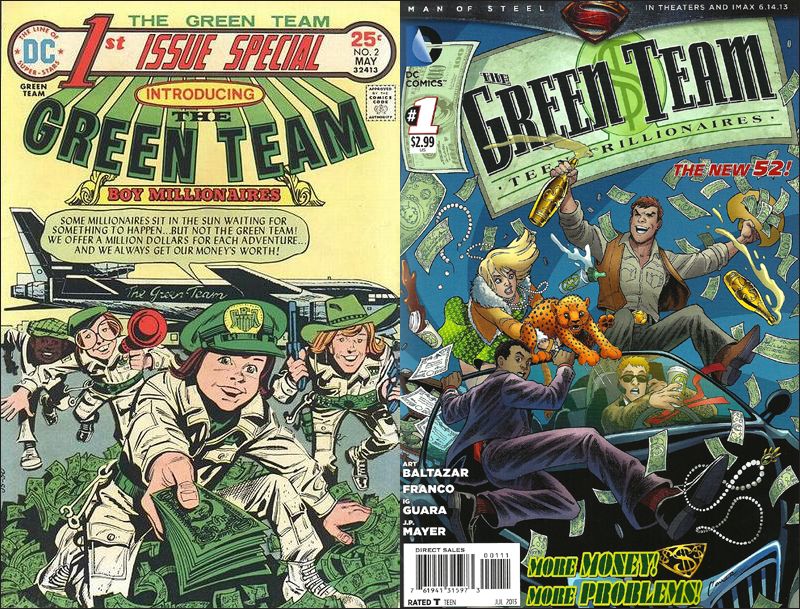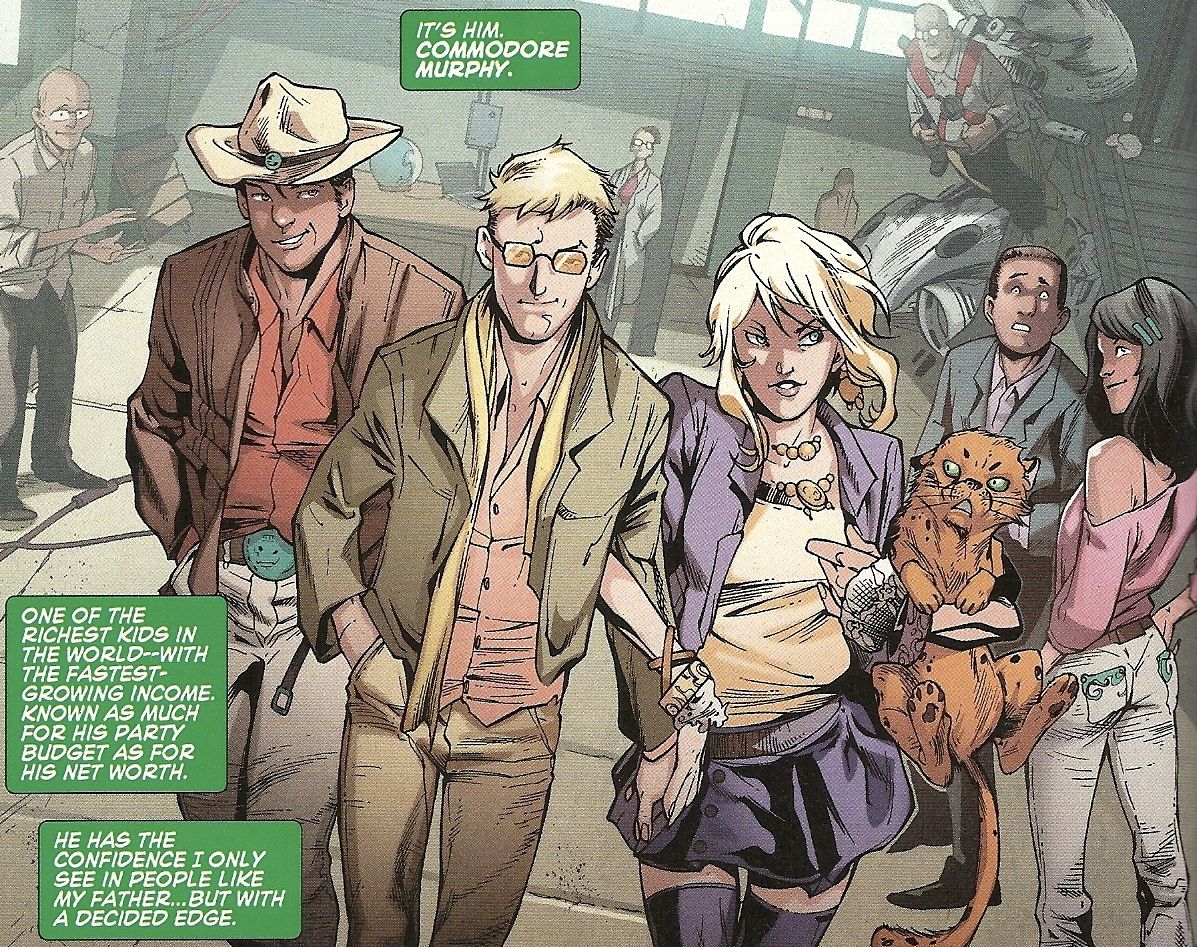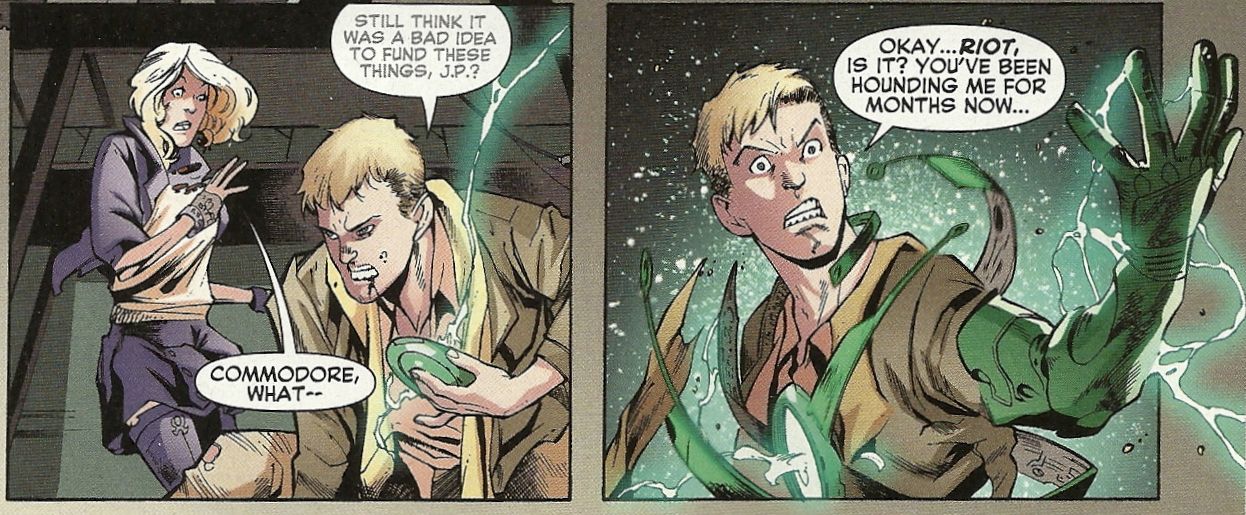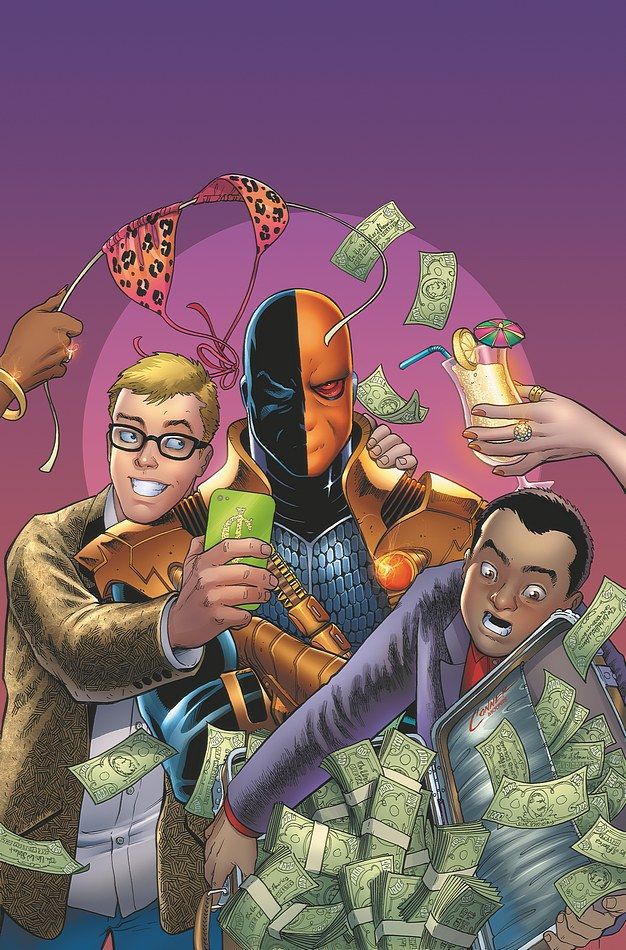If money is power, can a superlative amount of money be a super-power?
I don't mean here in the real world, where the answer to that question is a rather obvious yes, provided we're using the word "super-power" metaphorically, and referring to things like saving lives and effecting positive change in general. No, I mean in a fantasy world where super-powers are real, like the DC Universe, the setting of The Green Team: Teen Trillionaires, a new series that seems to be positioning itself to explore the question.
Certainly simply being very, very rich has been a key part of plenty of superhero origins, but Bruce Wayne still had to do an awful lot of studying and training to become Batman, even after buying all those gadgets and vehicles, and Tony Stark still needed to be a super-genius to invent and maintain his very expensive suits of armor.
At least one member of the new Green Team seems to be interested in buying his way into the life of superheroics, a potentially interesting angle for the new series and probably a necessary one, given the state of the comics market and DC's place in it.
As pre-created premises ripe for exploitation go, the Green Team has to be pretty close to the bottom of DC's rather formidable barrel (to which ideas have been added for about 75 years now), if not actually resting comfortably at the absolute bottom. After all, the original Green Team (who were boy millionaires, not teen trillionaires) appeared in a single 1975 issue of DC's 1st Issue Special anthology, which launched the careers of never-weres like Jack Kirby's Atlas and The Dingbats of Danger Street, Robert Kanigher and company's Lady Cop, Gerry Conway, Steve Skeates and company's Codename: Assassin, and a pre-Batman and The Outsiders team of freak heroes called The Outsiders (along with the actually successful Warlord of Mike Grell, and the blue-skinned alien version of Starman that James Robinsion would make great use of a few decades later; Robinson also revived Atlas and Codename: Assassin for his run on the Superman books).
Created by Joe Simon and Jerry Grandenetti, this Green Team didn't go anywhere, and their potential new series was a victim of the famed DC Implosion. Their only appearances since have been tongue-in-cheek cameos, appearing in the limbo issue of Grant Morrison's Animal Man issue, for example, or alongside other boy groups in a late '90s, Karl Kesel-written issue of Adventures of Superman.
If the Green Team didn't have much of a chance in the more genre-diverse DC of the 1970s, back when Uncle Scrooge and Richie Rich were much larger presences in U.S. comic book culture, what chance do they have in 2013, when DC is seemingly struggling to keep 52 series ongoing, but canceling them faster then they can be replenished?
Well, I'd say the prognosis is grim, but I would imagine everyone involved knows that as well or far better than I do, and hopefully a short, eight-issue lifespan has been built into planning for the series, so if it doesn't last, it will still make for a good miniseries or trade collection (ditto The Movement, which was announced and marketed alongside Green Team; that book doesn't even have the scant pedigree of Green Team, but probably makes up for it by having a writer with a very vocal fanbase like Gail Simone attached to it).
DC done a good job in at least assembling a great creative team for the book. It's written by Art Baltazar and Franco, best known for their Tiny Titans and Superman Family Adventures (both of which Baltazar also illustrated) and their scripting of Johnny DC books like the latter bits of Billy Batson and the Magic of Shazam. And it's penciled by Ig Guara, a talented artist who drew those charming (and quite nice-looking) Pet Avengers books for Marvel (J.P. Mayer is inking his work here).
They've certainly freshened up the concept a bit. In addition to making the stars teenagers instead of a little boys and inflating their net worth to something more impressive by today's standards, they've also made the characters more diverse and reflective of their potential readers.
Original characters Commodore Murphy and J.P. Huston are still around, although the latter has darker skin and sprinkles his dialogue with Spanish.
The name Cecil Sunbeam is, too, but instead of being assigned to a little boy director, it belongs to actress/singer of the Disney pop-star mold. J.P. has a little sister named L.L., adding another female character.
And African-American character Abdul Smith, a shoeshine boy who was awarded a small fortune by a bank computer error and managed to multiply it into a large fortune before returning his accidental windfall, has been replaced by Mohammed Qhat'tanii, a prince, who also serves as our point-of-view character.
The original premise of wealthy boy adventurers willing to pay anyone who could promise them worthy adventures is gone, replaced with The Commodore as the head of a clique of celebrity mega-rich teens, which Mohammed is trying to join. We meet them at a "Poxpo," a pop expo in which scientists (mad and sane) set up their wares on short notice in an empty warehouse, rave-style, to bid for investments from the Green Team. Before issue's end, a (new) supervillain attacks, and we learn that the Commodore has been trying to buy superpowers, including a super-suit he dons to fight off the villain.
The shift in focus is no doubt necessary — at least for a DC comic book. While the New 52 has given the publisher enough titles that they've felt confident in dabbling with other genres, those other genres are never more than hybrid ones, and the shared-setting dictates they all have to be superhero comics in one form or another. So they can't do straight Westerns or war comics or horror or sword-and-sorcery, but must instead do superhero Westerns, and superhero war comics, and superhero horror and sword-and-sorcery-and-superheroes.
Like the recently deceased Sword of Sorcery, featuring a reimagined Amethyst, Princess of Gemworld, that will likely end up leading to not-very-good comics that don't last very long. The tone of the writing and style of the art all but dictated by the New 52 (and, to be fair, DC Comics' DCU books of the few years prior to the relaunch as well) means this book can't — and here doesn't — ever get as silly or wild or funny as Baltazar and Franco's past work for the publisher, and while Guara's a great artist, and a far better-than-average New 52 artist, he's still working well within the range of a modern superhero house style that reads just fine, but doesn't exactly distinguish this book from the pack. (Remember, DC's got about 50 books of its own competing against The Green Team, and that's before you even get to the comics of Marvel, the remaining three publishers of The Big Five, and the scores of new comics released every Wednesday).
But the publisher's essentially painted itself into a corner, and at this point have to make everything they do a superhero comic to sell to their readers of superhero comics, and so the solicitation for the second issue includes talk of Sunbeam getting a cybernetic arm, and the cover for the third issue prominently features Deathstroke, the Terminator.
I can't imagine the book's long for this world — in fact, I'd bet a trillion dollars it won't make it a year — at least not when DC superhero fans have some 15 Batman books, some five Lantern and Super books and three Justice League books to go to first if they want to read DC superhero adventures.
But it's nice to see the publisher at least trying new old things, even if they're keeping one foot in their comfort zone, and it's always nice to see talented writers and artists getting to do their thing.
So Green Team: Teen Trillionaires? Grab it while it still exists!




